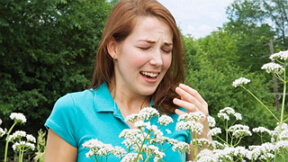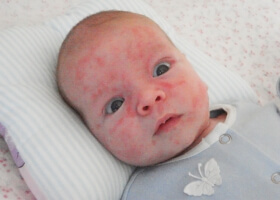Allergy to pollen
 Pollen allergy is a group of allergic diseases caused by the pollen of plants, characterized by acute inflammatory manifestations on the part of the mucous membranes and skin. This disease is characterized by a clearly repeating seasonality, which coincides with the flowering time of certain allergenic plants. The severity and nature of clinical manifestations on pollen of plants directly depends on the sensitivity of each particular organism to pollen allergens, as well as the presence of concomitant diseases and allergic reactions.
Pollen allergy is a group of allergic diseases caused by the pollen of plants, characterized by acute inflammatory manifestations on the part of the mucous membranes and skin. This disease is characterized by a clearly repeating seasonality, which coincides with the flowering time of certain allergenic plants. The severity and nature of clinical manifestations on pollen of plants directly depends on the sensitivity of each particular organism to pollen allergens, as well as the presence of concomitant diseases and allergic reactions.
Allergy to pollen( pollinosis) first became widely known in 1914, when practically the entire population of the village located in the south of France, due to the sharply developed edema of the mucosa, was gripped by a real horror in front of an unknown disease. In our country, scientists first encountered a massive manifestation of pollen allergy in the mid-sixties in the Kuban, after the ragweed brought from America ambrosia. To date, in Russia alone, about 15% of the population suffers from pollen pollen, and after 14 years of age, mostly girls suffer, and up to 14 - boys.
The allergy to pollen is caused solely by the pollen of plants that have allergenic properties and belong to producing a truly huge amount of flying pollen by widespread wind-polluted plants. Depending on the period of flowering of allergenic plants, pollen allergy has three peak incidence: spring, summer, autumn, although in some patients certain clinical manifestations of this type of allergy can be observed throughout the three periods, beginning in the spring and ending in the autumn.
• The first peak period of pollen allergy is April and May. In this period, the allergy to pollen of birch, ash, oak, maple, poplar and walnut
predominates. • The second period of pollen allergic manifestations falls on the time interval from June to August. In these months, cereals are beginning to flourish: bluegrass, rye, wheat grass, fire, corn, etc. Also in June, there is an increased concentration of poplar fluff in the air, so the allergic reactions that appeared at this time are more often associated with it. In contrast to the acute reaction to pollen, the allergy to poplar fluff has a less pronounced clinical picture of
. • The third pollen pollen allergies are autumn, when the air pollen of various weed plants predominates in the air, among which the most allergenic activity is possessed by quinoa, hemp, dandelionAnd of course ragweed
The pollen allergy is not officially classified, therefore it is customary to subdivide it depending on the degree of severity and localization of the pathological process. According to this, there are:
• Allergic skin diseases
• Allergic eye diseases
• Allergic diseases of the lower and upper respiratory tract
• Allergic manifestations of
• Seldom observed clinical manifestations of the pollen etiology
The most common manifestations of pollen allergy: contact( allergic) dermatitis, Urticaria, Quincke's edema, allergic conjunctivitis, bronchial asthma, allergic rhinosinusitis / rhinitis. These clinical manifestations of pollen allergy to plants can occur both in combination and independently. Less often, due to the influence of pollen allergens, there may be changes in the digestive, cardiovascular, genitourinary and nervous systems.
An allergy-pollen must have the following properties:
• Volatility and lightness, i.e. Ability to spread over sufficiently long distances
• High allergenicity / antigenicity, i.e. Belong to the genus of
plants widespread in the area. • The diameter of the pollen grains should not be more than 35 microns. It is due to such microscopic dimensions of pollen that it is possible to create in the air a very high concentration and to ensure its unobstructed penetration into the respiratory tract
The composition of pollen of plants can contain up to ten antigenic components, which are present not only directly in the pollen grains, but also in the leaves and stems. The most pronounced allergenic property is exina( the outer shell of pollen grains).It was found that the damage to the mucous membranes causes a water-soluble fraction of the pollen allergen, and contact dermatitis is fat-soluble( especially in case of contact of the allergen with the skin).
As a rule, the pollen allergy is caused by wind-pollinated plants, since the pollen of such plants is much higher in the air than the pollen of plants pollinated by insects.
Typically, wind pollen pollen is released early in the morning, but reaches the highest concentration in the air in the daytime and / or early evening, which is caused by higher air circulation during these hours. In cities, the concentration of pollen in dry weather is much higher than in the damp and rainy
Symptoms of pollen allergy
Symptomatic of this disease is mainly associated with damage to the mucous membranes of the eyes and upper respiratory tract. The most typical clinical symptom of the disease is rhinoconjunctivitis syndrome, which combines allergic signs from the upper respiratory tract, nasal mucosa and the eye mucosa.
Allergy to pollen almost always begins at the beginning of its course with the characteristic signs of conjunctivitis: burning and itching of the eyes, sensation in the eye of the foreign body, lacrimation and photophobia, conjunctiva slightly red, eyelids swollen.
Simultaneously with conjunctivitis, characteristic signs of rhinitis are observed: itching at the site of nasal passage into the pharynx, characteristic attacks of prolonged sneezing, which is accompanied by abundant discharge from the nose of the mucus, pain in the frontal and maxillary sinuses.
In addition to impairment of respiratory functions, patients have cracks in the ears and pain in the parotid region. Ear symptoms are often accompanied by nausea, which results in vomiting.
As pollen from the surrounding air disappears, all of the above symptomatology begins to weaken and gradually fades to nothing.
The severity of the manifestations of the disease directly depends on the degree of sensitivity of a particular person to inhaled allergens and especially on the amount of inhaled pollen. With the increase in the amount of pollen that enters the mucosa and the respiratory tract, the symptoms of the disease become more pronounced.
In addition, there is a clear association of allergy to pollen with such allergic diseases as bronchial asthma, food allergy, dust allergy and allergy to medicines.
Diagnosis of pollen allergy is based on external examination of the patient, careful questioning and results of skin allergic tests
Pollen allergy - treatment of
. If a person has increased sensitivity to pollen of plants, it is unfortunately impossible to cure this to date. That is why the most effective and perhaps the only method of treatment so far is the exclusion of contact with a provoking allergen. The current treatment of pollen allergy is the conduct of specific immunotherapy with allergens, which consists in the subcutaneous administration over several weeks of ever higher doses of a provoking allergen. In response to such a gradual introduction, the body begins to produce a kind of "antidote" to this allergen. Specific immunotherapy should be carried out in advance, even before the onset of flowering allergy-provoking plants. However, you should know that if there are any signs of exacerbation, this type of treatment is absolutely contraindicated. Carrying out immunotherapy requires the patient to have a lot of patience, since until stable results are achieved, it must be carried out for at least three years. That is why the most common method of treating pollen allergy is drug therapy with vasoconstrictors( galazoline, oxymetazoline, naphthyzine) and antihistamine( loratadine, taewegil, diazolin, suprastin) drugs, the regimen and dosage of which should be prescribed only by a qualified doctor. To treat the symptoms of conjunctivitis and to exclude the possible subsequent development of a purulent process, the eyes should be instilled with the r-rum of the albucid
Prevention of allergy to pollen
The most effective way to prevent pollen allergy is to completely eliminate contact with provoking pollen. The ideal option is to temporarily leave the flowering area that provokes the development of plant allergies. If this is not possible, the following recommendations should be adhered to during flowering of quarantine plants:
• Refrain from trips outside the city and walks in the forests and parks of
• Open doors and windows in the office and apartment of
• In windless weather, in the evening andAfter the rain, the room should be ventilated, while the open door or window should be hung with gauze or
sheet moistened in water. • On hot, windy days, it is best to refrain from entering the street, as in such conditions the concentration of dusts in the air is highest. If this happens, you should immediately change clothes
on return. •
should be showered at least twice a day. • After washing, it is strictly forbidden to dry things outdoors( balcony or street), because pollen
will be deposited on themThe apartment should be wet-cleaned daily by
These recommendations should be carried out regardless of whether( at work, at home, at a party) where the person predisposed to pollen allergy is located.



